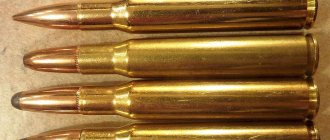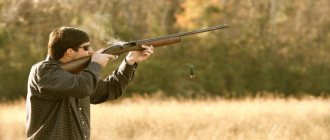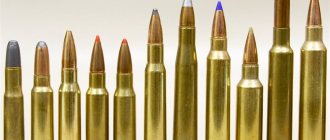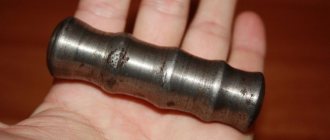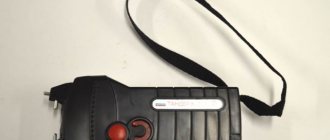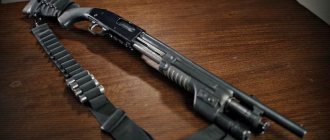- April 29, 2019
- Weapons and ammunition
- Michael
Many people interested in weapons are well versed in the different types and argue about the merits. However, not everyone knows how caliber is measured, and this is precisely one of the most important characteristics of any weapon, from a pistol and machine gun, to a hunting shotgun and a heavy machine gun. Therefore, it will be very useful to talk about this in a little more detail.
What caliber measurement systems exist?
The most common weapons in the world are rifled weapons - this includes pistols, machine guns, machine guns and rifles. Only shotguns and some smoothbore revolvers are usually classified as smoothbore. Therefore, let's start dealing with the issue with rifled weapons.
So how is caliber measured? There may be several options here.
The most common method in our country is to determine caliber by field. That is, it is the diameter of the sleeve that is measured - this is the simplest option.
But there are other ways. For example, some experts prefer to determine the caliber of a weapon rather than ammunition. In this case, the distance between the grooves in the barrel can be measured. This may cause some confusion. After all, the cartridge always has a smaller diameter than the barrel through which the bullet fired from it passes. For clarity, let’s look at shooting from a hunting carbine “Moose”. It is loaded with 9 mm caliber cartridges. When fired, the bullet passes through the rifling, the distance between which is 9.27 millimeters. That is, different experts will evaluate the caliber differently - some will say that it is 9 mm, while others will say 9.27. But at the same time the conversation is about the same weapon.
A similar measurement system is used for weapons with polygonal rifling. But in our country this method of creating weapons is not very popular, so we will not discuss its principle, advantages and disadvantages in detail.
Now let’s talk in more detail about the different calibers of weapons.
Criteria for choosing the optimal caliber
The 12th is most acceptable in the following cases:
- When the game is a large animal (boar, elk, large subspecies of deer, bear, etc.). When hunting such game, especially if it is an aggressive species capable of attacking a person, the stopping effect of the bullet comes first.
- When shooting at game with buckshot . Due to their larger diameter, buckshot fills the cartridge less efficiently than a shot charge. Therefore, a more powerful gun is more suitable for this case.
- When it is intended to shoot small game with a shot load at the maximum distances of its effectiveness. 12 gauge holds 25-30% (Super Magnum 60-80%) more shot than its opponent.
- When hunting is carried out from an ambush and there is no need to carry a gun for a long time or keep it suspended for a significant time. The reason is the significant mass of the weapon - 3.5...4 kg .
- For firing traumatic cartridges with high destructive power or cassette cartridges with traumatic damaging elements.
- For firing special cartridges filled with tear gas or giving a flash-and-noise damaging effect.
- If in the area where the owner of the weapon lives, the number of weapons stores is very limited . Ammunition of this type is most widespread.
20th is most suitable in the following cases:
- For walking hunts , when you have to travel long distances while searching for game. In this case, the small weight of the gun (2.6...3.1 kg) makes it much easier to carry.
- If you plan to shoot a small animal (fox, roe deer, wolf, etc.), when there is simply no need to use a more powerful gun.
- If you plan to shoot game with shotgun cartridges at short and medium distances.
- For a person with low weight . Less recoil when firing in this case can be of major importance.
- When regular use with a large number of shots , as a result of which it is necessary to reduce the load on the shoulder from repeated recoil.
- If a weapon is purchased for storage in the house for the purpose of self-defense . In this case, the key parameters are the smallest weight and dimensions of the weapon, as well as minimizing its damaging factors (only the attacker should be hit, but not strangers).
MiscellaneousComment
Caliber of smoothbore weapons
Most hunters are intimately familiar with smoothbore weapons. Which is understandable, most often in our country this includes hunting rifles. With a shorter combat range, they provide a more reliable hit and severe wounds - most often a hit leads to the rapid death of the animal. In addition, every healthy person over 18 years of age can purchase a shotgun. For a rifled one, you will have to buy a smoothbore one and wait 5 years without breaking the law. Therefore, most people don’t even think about purchasing it.
So, what are the calibers of smoothbore weapons? This is where the measurement system can seriously confuse an ignorant beginner. After all, in our country the most common calibers are 12, 16 and 20. You can also find 28 and 32. Very rarely you come across 24, which was discontinued several decades ago. And finally, the .410 caliber is used for smoothbore weapons.
It would seem that everything is clear. But when studied in practice, it turns out that 28 caliber is sharply inferior in size to 12. And .410 caliber, in turn, is significantly smaller than 16. How could this happen?
To understand this, you need to dive into history, to the times when the caliber system was just being created. By the way, it operates today almost all over the world, if we talk specifically about smooth-bore weapons. If you contact a gun store seller in England or the USA, asking for a dozen 12 or 16 gauge cartridges, he will immediately understand what the buyer needs. With rifled ones, everything is more complicated - we’ll return to this issue a little later.
Calibers appeared long before the widespread introduction of the metric system. And the link was made to the pound. Connoisseurs know that at one time there were many pounds, characteristic of different countries and loads. Therefore, English was used as a standard - translated into the metric system we are used to, this is 454 grams.
Now imagine 454 grams of lead, the main material from which bullets were made. Muskets and arquebuses had different barrel diameters. Therefore, the bullets for them had to be seriously different. For one arquebus, a larger one, only 12 bullets could be cast from a pound. And for the other, in the manufacture of which they decided to reduce recoil, it was possible to make as many as 20 bullets. This is what served as the basis for the introduction of the caliber system. That is, a modern caliber for smoothbore weapons shows how many classic spherical bullets suitable for a particular barrel can be made from 454 grams of lead. As you can see, everything is quite simple. And at the same time it explains why 28 gauge is smaller than 12. It is not surprising that the pockets in a 20 gauge bandolier are much smaller than in its 12 gauge counterpart. Still, the cartridges themselves will be significantly smaller in diameter.
Of course, some hunters are interested in knowing how many mm are in 12 gauge. Alas, there is no specific coefficient for converting from one caliber system to another. Therefore, you will have to take a cartridge case and arm yourself with a ruler. Then you can easily determine how many mm are in 12 gauge - 18.5. Quite a lot, considering that the Utes heavy machine gun has only 12.7 mm.
Today in our country 12 gauge is considered the largest hunting caliber. There used to be 8 and even 4, but their production was discontinued many years ago. The reason is too much recoil and excessive consumption of gunpowder. Not surprisingly, the 4 gauge has a diameter of 26.5 mm - this is a real mortar, not a gun! The bullet will put the bear in place, but there will be little left from the hunter’s shoulder, especially if he shot offhand.
Are you wondering how many mm are in 16 gauge? Here it will be 16.8. And, for example, the smallest 32 caliber produced in Russia (more precisely, in the USSR) has a diameter of 12.5 - almost the same as that of the Utes, which is rightfully considered a terrible weapon.
But it seems that while talking about hunting rifles, we forgot about the .410 caliber. It certainly doesn’t fit into a system tied to the pound. After all, it is impossible to make 410 bullets from 454 grams of lead - it will be an ordinary small shot.
The fact is that the .410 caliber appeared in our country relatively recently - in the 90s. But in the UK it has been popular for many years, considered for women or children. Therefore, when a few guns appeared using cartridges of this caliber, it was decided to leave the old markings. If we convert it into millimeters, it turns out that these cartridges are even smaller than 32 caliber - about 10.2 mm.
Now you know how the caliber of smoothbore hunting weapons is measured. Let's move on to a more serious type - rifled.
Negative sides
This type of ammunition is highly not recommended for novice hunters to use for hunting, since choosing the optimal amount of gunpowder and shot to kill an animal, but at the same time leaving it with trophy value, will be extremely problematic. With twenty and twelve gauges everything is much simpler.
Also, many arms factories today give preference to 12-gauge shotguns, so choosing a reliable “companion” for hunting will be very difficult. One of the best double-barreled shotguns for beginners is considered to be the 16-gauge TOZ BM with a horizontal barrel arrangement. It has decent technical characteristics and is unpretentious in operation.
Domestic system for measuring cartridges for rifled weapons
This is where confusion arises most often. The fact is that the caliber of rifled weapons has different markings in different countries. The Soviet and American systems are considered the most famous in the world - most other countries adapted to them. First, let's look at ours.
Everything is quite simple here - the size of the calibers is indicated in mm. It is no coincidence that you can often hear: caliber 5.45 mm, 7.62 mm, 9 mm or 12.7 mm. Yes, these are the most common calibers in our country. They are used in machine guns, pistols, rifles, and machine guns.
Here the measurement system is as simple as possible - the diameter of the main part of the sleeve is measured and that’s it. The question no longer arises of how to determine the caliber of a cartridge. If you have a cartridge and a ruler (or better yet, a caliper), just determine the diameter and you will know the caliber.
This system is used in many countries. But still not everywhere. Therefore, we will tell you about other existing options.
American measurement system
In fact, the American caliber scale is derived from the English one, as is the language. We'll talk about the differences a little later.
It is important that the conservative British did not immediately want to switch to the metric system of measurements, which was popular throughout the world, using pounds, miles and feet for a long time.
To measure small objects, a unit such as an inch was used - 25.4 mm. However, for the calibers of rifled weapons this clearly turned out to be too much. Therefore, lines and even dots came to the rescue. An inch consists of 10 lines, and 10 points, in turn, make up 1 line. These units were much better suited for weapon calibers.
Now let's pay attention to the American markings of cartridges. Here you cannot see the usual 7.62 or 9 millimeters. Everything is much more complicated – at least when you’re not used to it. There are calibers such as .38, .40, .41, .44, .50 and many others like them.
All these gauges are measured in points, which, as mentioned above, are parts of an inch. That is, we take a weapon with a barrel diameter of half an inch - 0.5 inches. If you convert it into points, it turns out that this is already 0.500. To reduce confusion, let’s remove the first zero—it won’t confuse a knowledgeable person. It turns out .500. And the last zero does not play any role here - let’s cross it out too. So we got the .50 caliber - one of the most terrible ones used by the American army. What will happen if we transfer it to the system we are familiar with? To do this, multiply 0.50 by 25.4 (the number of millimeters in an inch). And we get...12.7 millimeters! That is, the Browning .50 heavy machine gun is quite consistent with our 12.7 mm “Cliff”!
However, when marking some calibers, the metric system is also used. For example, the popular M4 automatic carbine uses 5.56 mm cartridges, not .22.
English system
As mentioned earlier, the American gauge system is entirely derived from the English one. But there’s nothing you can do about it - at one time Great Britain, which conquered half the world, set fashion in a variety of areas, including the arms industry.
And in general, the calibers used in England are still very similar to the American ones. There is only one difference - having crossed out the first zero coming before the dot as unnecessary, the English experts did not cross out the last one. Apparently, British stiffness and dislike for excessive simplification, for which the Americans are famous, took their toll.
That is, a heavy machine gun here has a caliber of .500, and a small machine gun, which in the USA is labeled as .22, will here be designated as .220. The difference, as you can see, is minimal. Once you understand one system, switching to another will be quite easy.
Differences between the considered calibers
- The nominal diameter of a 12 gauge barrel is larger than that of a 20 gauge - 18.5 versus 15.6 mm .
- For 12-gauge shotguns, many more options for loading combat and special cartridges have been developed. They are more readily available for sale. It is also suitable for Super Magnum cartridges with an initial shot velocity of up to 450 m/s (versus 330 m/s for Magnum class ammunition)
- The mass of the warhead and the weight of the powder charge of 12-gauge ammunition exceeds that of 20-gauge ammunition.
- 12 gauge has much greater stopping power .
- The recoil when fired from a 12 gauge shotgun is significantly higher.
- 12 gauge weapons have greater combat sharpness . The sharpness of the battle is the ability of the shot to penetrate the target being hit and cause destruction in it. It is the most important characteristic along with accuracy and accuracy of fire. The most important characteristics that influence the sharpness of the battle are: the speed of the pellets at the moment they hit the target; the shape of these pellets. The sharpness of the battle is higher, the more pellets from the total number that have retained their correct spherical shape. This factor depends on the hardness of the shot, the quality of its manufacture and the degree of its deformation during friction against the bore during a shot.
- 12 gauge provides excellent accuracy of shot loads at long distances, up to 50 meters .
- 20 gauge provides good dispersion of shot charges at short and medium distances, when excessive accuracy can practically tear apart a small hunting object.
- 12 gauge shotguns weigh more . Its reduction due to the introduction of light alloys, shortening the barrel and a number of other measures reduces the weapon's grip (controllability), increases recoil when fired and, in some cases, worsens its balancing.
- There are many more 12 gauge shotgun models on the market than 20 gauge ones.
Old Russian system
Experienced weapons experts, reading the article, understanding the lines and dots, will definitely remember the most Russian rifle - the three-ruler. They will ask themselves whether the lines in the article and in the title are connected with each other? And they will be absolutely right.
The fact is that Russia switched to the metric system for measuring calibers after the 1917 revolution. And before that, the same system of lines was used as in England.
As is clear from the common name, cartridges for the Mosin rifle have a 3-line caliber. That is, they correspond to the American marking .30. How much will it be if converted to Soviet caliber? We multiply 0.3 by 25.4 and get a very expected result - 7.62 millimeters. It was this cartridge that the Mosinka used, and today it is used by the SVD and many other types of weapons.
We distinguish not only the caliber, but also the length of the sleeve
However, having dealt with the caliber, or, more precisely, the diameter of the sleeve, you should not forget about other parameters. Even with smooth-bore weapons, not everything is so simple. For example, knowing how many mm are in 12 gauge, it will not always be possible to buy the required ammunition. In the store, an experienced salesperson will definitely ask what kind of cartridges the buyer is interested in - 12 × 70, 12 × 76 or maybe 12 × 89! That is, its length also has a significant influence on the cartridge.
It's about the same with rifled weapons. For example, take a 9mm cartridge. This caliber was and is used in pistols such as: Makarova, Parabellum, IZH-17, Mauser. But the cartridges are completely different. The Makarov pistol requires a 9 × 18 mm cartridge. The old, proven Parabellum used 9 × 19 mm cartridges. To shoot the IZH-17 pistol, you will have to find 9 × 17 mm cartridges. Well, the famous Mauser will require 9 × 25 mm cartridges. Of course, in most cases such cartridges are not interchangeable. Most often, they simply will not fit either in the magazine or in the barrel of the gun. Sometimes there are exceptions. But even in such cases, the use of unsuitable cartridges is undesirable - most often this leads to the destruction of the pistol after several shots.
Another striking example is the already mentioned 7.62 mm caliber. For example, the SVD rifle uses 7.62×54 millimeter cartridges. And the good old AK (like the Degtyarev machine gun and the Simonov self-loading carbine) was designed for the 7.62 × 39 cartridge, innovative for its time. Of course, the characteristics of these two ammunition are very different.
Such examples quite clearly show that with the same diameter, cartridges can have different sleeve lengths. This has a serious impact not only on the combat characteristics of the ammunition, but also on the weapon for which it is designed.
"Brenneke"
German-made cartridges that are ideal for hunting with IZH-27 16 caliber or any other gun designed for this type of ammunition. It’s worth noting right away that the cost of Brenneke shot cartridges leaves much to be desired, however, their quality is excellent. The company has been producing ammunition for over 100 years, establishing itself as one of the best European manufacturers. The main advantages of the Brenneke are its high accuracy of fire and good stabilization during flight, which is especially important when shooting through dry grass or branches. Bullets have a very intricate shape, so it is not possible to upgrade the ammunition by adding additional powder, because even a minor flaw can lead to catastrophic consequences.
What does caliber affect?
The caliber (not only the diameter, but also the length of the cartridge case) primarily influences how much powder can be stored in the cartridge. Experts know that just half a gram of gunpowder can significantly increase lethality or effective firing range.
In addition, the stopping effect depends on the caliber (namely the diameter), which is not at all surprising - where a bullet from a 5.56 mm cartridge can easily pass through the muscles, stitching them like a needle, a blunt-nosed (not even expansive) bullet from a 9 mm cartridge will actually do terrible destruction. A larger diameter causes more severe wounds. On the other hand, the 5.56 assault rifle cartridge provides a much greater range than the 9 mm pistol cartridge, even if it is used in a submachine gun or hunting carbine.
"Tacho"
One of the most inexpensive types of imported ammunition, which was used by the 2000 Olympic champion N. Milchev during sports shooting competitions. The main advantage of this company’s products is the stability of the combat, as well as pinpoint accuracy when loading cartridges. The stores offer ammunition with shot numbers from 4 to 9 (great for duck hunting). In addition, the company also produces samples loaded with bullets or buckshot. The length of a lead bullet for a 16 gauge case is approximately 32 grams.

